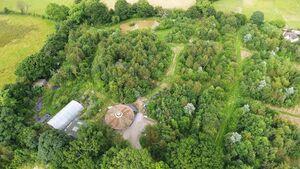Forest garden
A forest garden, or food forest, is an edible ecosystem that mimics forest structure and function and is consciously planted to have a polyculture of mutually beneficial plants and animals to provide food, fuel, fiber, fodder, fertilizer, and farmaceuticals.[1] It expands food gardening across the full range of succession, from field to forest. Fruits, nuts, vegetables, herbs, mushrooms, and other useful plants are grown and animals are raised in a method that copies nature to provide a diverse and high-yield self-maintaining garden.
Forest gardens are self-maintaining through heavy use of perennials and self-sowing annuals. Healthy soil is produced through mulching undisturbed soil and fertility is improved with nitrogen-fixing plants and dynamic accumulators. Pests are controlled by growing fragrant plants that confuse them, providing shelter and food for insectivorous birds and predatory and parasitic insects, and planting in blocks that limit their spread.
Forest gardens place an equal emphasis on all layers of a planned forest, whereas agroforestry is a similar approach that grows crops in land primarily focused on trees for lumber, pulp, or other wood products, and forest farms grow under the canopy of existing forests. All three have parallel approaches that sometimes lead to similar designs.
Contents
Links
Design
Location
Forest gardens can greatly vary, ranging in size from small to large, planted in both urban and rural areas, and privately or communally owned. A city homeowner can convert their backyard into a food forest, such as New Jersey YouTuber James Prigioni documented, or public city parks can be established like the Beacon Food Forest in Seattle, Washington to provide fresh produce their community.
Temperate land with plentiful rainfall where deciduous forests natively grew is ideal. More arid parcels are plantable if watering needs are accounted for and wind protection is provided. While good exposure to the sun is needed, forest gardening methods are adoptable for shadier plots.
Assess
Carefully inventory the land before adding or removing any plants. If using existing woodlands and only minimal changes can be made to the trees, consider a forest farm approach instead.
Plant selection
Plants are selected to fulfill multiple criteria:
- Provide an abundance of useful products or nutritious and enjoyable food. Experiment, but grow food that you are already familiar with and use. Strive for plants that are diverse in the time of growth and harvest.
- Use plants that are resilient with very little or no-maintenance once established. Select plants to mimic specific structures or functions of self-sustaining forests to gain their specific advantages. If elements are not satisfied, this need must be provided externally for the garden to prosper. However, through careful selection, food forests are able to provide for their own needs to reduce or eliminate human workload and interaction. To make the natural productivity of forests available, it is important to find a diversity of yields, including the cutting of labor and other costs, from the ecosystem.
- Protect and restore the surroundings. Select plants that provide habitat for beneficial or endangered animals and grow threatened native species. Choose plants that are able to minimize erosion or help process water runoff when needed.
- Select plants that are aesthetically pleasing.
- Grow plants that are provide economic sustainability.
- Connect you personally with your garden.
Realize some crops, especially sun-loving ones, are unsuited for growing in a forest garden.
Structure
The physical structure of a forest garden is comprised of five elements:
Vegetation layers
- Main article: Vegetation layers
The vegetation layers are the vertical structure of the forest:
- The canopy: the tallest trees in the system. Large trees dominate but typically do not saturate the area, i.e. there exist patches barren of trees.
- Understory layer: trees that revel in the dappled light under the canopy.
- Shrub layer: a diverse layer of woody perennials of limited height. includes most berry bushes.
- Herbaceous layer: Plants in this layer die back to the ground every winter (if winters are cold enough, that is). They do not produce woody stems as the Shrub layer does. Many culinary and medicinal herbs are in this layer. A large variety of beneficial plants fall into this layer. May be annuals, biennials or perennials.
- Groundcover: There is some overlap with the Herbaceous layer and the groundcover layer; however plants in this layer grow much closer to the ground, grow densely to fill bare patches of soil, and often can tolerate some foot traffic. Cover crops retain soil and lessen erosion, along with green manures that add nutrients and organic matter to the soil, especially nitrogen.
- Rhizosphere: Root layers within the soil. The major components of this layer are the soil and the organisms that live within it such as plant roots (including root crops such as potatoes and other edible tubers), fungi, insects, nematodes, worms, etc.
- Vertical layer: climbers or vines, such as runner beans and lima beans.
Soil horizons
Vegetation density
Patterning
Diversity
References
- ↑ Jacke, Dave, and Eric Toensmeier. Edible Forest Gardens, Volume One. Chelsea Green Publishing, 2005. p 1.
